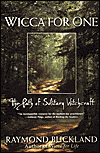
Raymond Buckland has published numerous books on Wicca and is credited, by none other than Ray Buckland himself, as bringing Wicca to the United States after being initiated and raised to the appropriate degree by Gerald Gardner in Scotland in 1963. While originally considering coven work the only legitimate form of Wicca, Buckland is now accepting, and embracing Solitary Witchcraft with his most recent offering, Wicca For One.
Much of the book is simply a rehash of Wicca for Life (2001 Citadel Press) and Buckland’s Complete Book of Witchcraft (1986 & 2002 Llewellyn) with a shuffling of words in the sentence, a line added about the Internet here, and a quote from a contemporary author there. That said, what Buckland provides the new person on the Wiccan path is a step-by-step guide to practicing Wicca.
One of the greatest disagreements I have with Buckland’s writing is his statement (page vii, Introduction) that ”Witch and Wiccan is basically the same thing.” Of all the Witches I know, none would agree with Buckland on this. Buckland states on page 27, that there is no dogma – although throughout the book I found many rules/doctrines. In fact, he writes often in black/white definite terms, Witches do this, Witches don’t do that, whether the topic is drugs or pollution such blanket statements are extreme. Another area in which one might disagree with him is his emphasis on the need for a balance of male and female worship and his statement on page 29, “…there are some groups (mainly feminist) who direct their worship exclusively at the Goddess. To my mind it is as unbalanced as is the Christian concept of an all male deity.” I found this bashing of another magical path troublesome and similar to the mainstream Christian bickering between denominations regarding which is the true way to practice.
What Buckland does offer in Wicca for One is a bit of mythology, a history of Wicca as a religion, an extensive description of assorted tools and how to consecrate them, the building of a Wiccan altar and construction of a ritual, directions for self initiation, wiccaning, handfasting and handparting. Although too brief, I found the heart of the book to be the descriptions and explanations of the Sabbats and Esbats. In fact, as I write this review I’m looking forward to using Buckland’s Dark Moon ritual in the coming days. There are sections about magic (I noticed that Buckland has in recent publications switched his spelling magick to magic) in general and specific including candle, color, poppets, cord, sex, protection, talismans, astrology, and herbal magic. He also includes chapters on various types of divination and healing. Buckland closes Wicca for One with several very good Appendices: a glossary of terms, magical properties of herbs and stones, and magical alphabets.
Buckland and I agree that for continued development you should read and research as much as possible. If your bookshelf or budget is small, you need only one book by Buckland in your core collection of magical books (peruse Buckland’s Bibliography for other titles), and if you are Wiccan and solitary, Wicca for One is a good choice.
~review by Denise Bell
Author: Raymond Buckland
Citadel Press, 2004
pp. 278, $14.95
